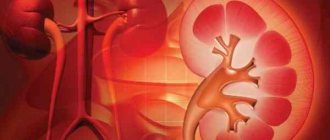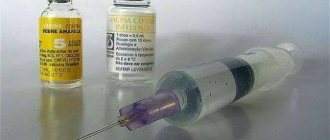Hemoglobin norms in newborns and infants
The highest levels of hemoglobin are observed in newborns (fetal hemoglobin), the volume of which in the first month is 50-90%, and by 6 months it decreases to 5%, and by the age of three it is completely replaced by adult hemoglobin. It binds and transports oxygen well, but is less resistant to environmental acidity and temperature. When the volume of such hemoglobin in a six-month-old baby exceeds the five percent threshold, this may indicate thalassemia (genetic pathology).
Anemia is common in premature babies. This is due to a deficiency of substances for the synthesis of red blood cells, not fully formed liver and bone marrow, which are responsible for the production of hemoglobin. This situation requires careful medical monitoring, and, if necessary, drug treatment and blood transfusions.
The table shows hemoglobin norms in newborns and children under one year of age:
| Age | Indicator (g/l) |
| 1-3 days | 145-225 |
| 1 Week | 135-215 |
| 2 week | 125-205 |
| 1 month | 100-180 |
| 2 month | 90-140 |
| 3-6 months | 95-135 |
| 6-12 months | 100-140 |
Iron protein levels in older children
In children under 2 years of age, hemoglobin changes. The lower limit of normal is 105 g/l, and the upper limit can reach 145 g/l.
At this time, the child begins to grow rapidly, so the hemoglobin content in the blood decreases. By 5-6 years the norm should not exceed 140 g/l.
READ Detecting diabetes mellitus by analyzing glycemic hemoglobin
If a doctor discovers anemia in babies at this age, then the pathology will be the result of some disease that was detected at 7 months or earlier.
If treatment is not started in a timely manner, then by the age of 5 the patient will experience a decrease in the indicator. By the age of 15, the amount of iron-containing protein in the blood becomes 112 – 160 g/l.
Video:
After a person turns 18, the level of hemoglobin in the blood stabilizes. For boys and men, the indicator corresponds to the range of 130–160, and for girls and women – 120–155.
Until the age of 11–13 years, the norm of red blood cells is not divided depending on gender. In children over 14 years of age, the norm is different for boys and girls.
Table 2. Norm in adolescents
| Age, years | Norm | |
| In boys | For girls | |
| 12 – 15 | 120 – 160 | 112 – 152 |
| 15 – 18 | 117 – 160 | 115 – 153 |
There are glycosylated and fetal hemoglobin. Glycolyzed is the product of the addition of glucose.
If its amount is below 4% and above 6%, then the doctor will prescribe additional tests. Most often, an elevated level indicates the presence of diabetes mellitus.
Fetal is found only in the blood of children under one year old. Gradually its level decreases. In adults, the blood should not contain this protein.
If more than 1% fetal hemoglobin is found in the blood, then serious diseases develop in the patient’s body.
Causes of low hemoglobin in infants
Low hemoglobin is usually caused by:
- insufficient hemoglobin synthesis due to lack of iron (iron deficiency anemia);
- increased destruction of red blood cells due to a certain disease (hemolytic anemia);
- acute and chronic blood loss (posthemorrhagic anemia).
The baby’s body suffers from a lack of hemoglobin, the main task of which is to provide each cell with oxygen and remove metabolic products (carbon dioxide). It contains iron in a bound form, which is why the blood has a red color. Low hemoglobin in an infant affects his well-being and development.
When he is active, has a good appetite and a healthy complexion, there is no cause for concern. A decrease in levels to 80-90 grams per liter requires treatment.
Anemia is diagnosed in premature babies, as well as newborns whose mothers suffered from iron deficiency during pregnancy. Late toxicosis, gestosis during pregnancy, and severe blood loss from the mother during childbirth often lead to anemia.
Anemia also occurs as a result of:
- lack of B vitamins and folic acid;
- pathologies of pregnancy and childbirth;
- hereditary diseases (spherocytosis and others);
- lack of fresh air and reduced motor activity of the baby.
Lack of fresh air and air baths can also cause anemia
What to do if your hemoglobin level deviates from the norm
With iron deficiency anemia that persists for a long time, the risk of delayed physical or intellectual development of the child increases. Oxygen starvation of tissues with a lack of hemoglobin develops faster than with its excess. For these reasons, a deviation from the norm in the direction of decrease is more dangerous than exceeding the average values.
Increased rates are often due to physiological reasons. If hemoglobin is high, it is necessary to normalize the child’s diet and ensure compliance with the drinking regime. Another reason for blood thickening may be too high a level of physical activity (this needs to be reconsidered). The absorption of iron can be hampered by a lack of vitamins B and C.
How to increase hemoglobin in a child
Reduced hemoglobin in a child is corrected by introducing foods high in iron into his diet. These include:
- nuts (peanuts, cashews);
- liver, meat products;
- lentils;
- oat flakes, buckwheat, wheat, barley;
- spinach.
Treatment of iron deficiency anemia
When anemia is diagnosed, the causes of its occurrence are determined and appropriate treatment is prescribed, including the following methods (depending on the etiology of the disease and its severity);
- taking iron-containing drugs (Ferronat, Totema, etc.);
- taking vitamin complexes (groups B, C, folic acid);
- physiotherapy;
- blood transfusion (at critically low levels).
Development of iron deficiency anemia in infants
Iron deficiency anemia occurs more often in infants than other types. Up to six months, normal hemoglobin levels depend on the mother’s adequate nutrition (with breastfeeding) or a properly selected formula. Breastfeeding is still a priority, because the protein ferritin contained in mother's milk helps the baby absorb iron 50% more efficiently. Lack of iron intake from food is one of the causes of anemia in newborns, therefore, it is important for the mother to eat properly.
When bottle-fed, iron absorption may be impaired due to improper diet. For example, the use of semolina and oatmeal porridges based on goat's and cow's milk leads to the cessation of hemoglobin absorption. This is due to the low iron content in the milk of cows and goats, as well as intestinal bleeding due to the consumption of maladjusted dairy products (blood leaks from the microscopic vessels of the intestine).
Presumably the bleeding is caused by infants' intolerance to cow's milk. In a child who is fed not with adapted formulas, but with cereals with real milk, they can be observed for up to two years. The development of this type of anemia is facilitated by violation of the rules for introducing the first complementary foods (earlier or later onset), diseases of the digestive system, and lack of vitamin B12, which helps iron to be absorbed.
The use of cow's and goat's milk can lead to impaired absorption of hemoglobin (we recommend reading: are there harmless infant formulas made with goat's milk?)
Prevention of anemia in children
Low hemoglobin in children can be prevented with a number of simple preventative measures, starting with preventing anemia in the expectant mother. Proper nutrition and daily routine play the biggest role. Help prevent the development of the disease:
- compliance with complementary feeding rules;
- balanced nutrition of the mother during pregnancy and breastfeeding;
- daily walks with your child in the fresh air;
- carefully monitoring changes in the baby’s condition;
- taking vitamin complexes containing iron, folic acid and vitamin C.
Symptoms of anemia
The pediatrician makes the diagnosis of iron deficiency anemia based on laboratory tests. The deviation of hemoglobin from the norm, the average volume of erythrocytes, the level of iron in the blood serum and its ability to bind iron, the concentration of hemoglobin in the erythrocyte and other indicators are taken into account. General signs of anemia that can be observed in a baby are also important in diagnosis:
- sweating;
- pallor of the skin, mucous membranes, conjunctiva of the eyes;
- poor appetite and sleep;
- dry skin;
- cracks in the corners of the mouth;
- brittleness of nails and hair;
- poor tolerance to physical activity;
- lethargy, moodiness, rapid excitability.
Main symptoms
To begin with, you should pay attention to the child’s behavior and his condition. With a lack of iron, increased fatigue appears, and the baby may have poor appetite. It is quite easy to identify this in an active child, when his energy disappears somewhere, he quickly gets tired, and headaches appear. Even such seemingly insignificant things can be symptoms of low hemoglobin in a child and a reason to consult a doctor.
The next signs of low hemoglobin are damage to the skin appendages. Nails become brittle, hair is also brittle, dull, dry. And the skin itself begins to peel off. Of course, one cannot say that this is a 100% iron deficiency. Brittle, peeling nails can also occur due to fungal infection. Therefore, you should not postpone going to the doctor.
What else could be happening to the child? Regarding the skin, let us add that it becomes pale, as do the mucous membranes. Weakness appears, dizziness and tinnitus are possible.
The symptoms of low hemoglobin in a child are quite extensive. These include changes in taste. In such a situation, it is possible to have an aversion to dairy products and replace them with meat or vegetables. It also happens that there is a desire to eat chalk or earth (“perverted taste”). The child may experience a slowdown in growth and weight gain.
Symptoms include the appearance of cracks and jams in the corners of the mouth. However, such a sign may also indicate hypovitaminosis, which is observed quite often in children. It is also worth checking the condition of the child’s tongue. If it is shiny and smooth, then this is also a criterion for contacting a doctor.
These are the main and most common symptoms of low hemoglobin in a child.
How to increase hemoglobin levels?
Having noticed symptoms of low hemoglobin in the baby, the mother should immediately ask the pediatrician for a referral for a blood test. Otherwise, the immunity of a 3-month-old baby will quickly decrease, and development will be impaired. The doctor will assess the baby’s condition, recommend diet, medications, and in severe situations, hospital treatment.
Only a blood test and subsequent consultation with a specialist will help you obtain accurate data.
The following also help increase iron levels:
- long walks in the air;
- physical activity (the baby can crawl, roll over, play on a developmental mat);
- minimum anxiety;
- healthy sleep.
Medicines
Medicines prescribed to children contain reduced iron. It is actively absorbed by the intestinal walls, which benefits the baby. Suitable medications for up to a year: Hemofer drops, syrup or drops Actiferrin, Maltofer, Ferrum Lek syrup (we recommend reading: Maltofer drops: instructions for use for children).
How much medication and how should the baby take it? The doctor prescribes the dose individually. For preventive purposes, drugs are prescribed at the rate of 1 milligram of active substance per kilogram of weight. For premature babies, the dosage is selected depending on weight:
| Premature baby weight (kg) | Daily dosage mg/kg |
| Up to 1 | 4 |
| 1-1,5 | 3 |
| Until 3 | 2 |
Actiferrin drops are very often used to normalize hemoglobin levels (more details in the article: Actiferrin drops for children: instructions for use)
For medications to really work, it is important to know how to take them correctly. It is best in the afternoon, when iron is absorbed more actively by the body. Before offering the drug to a baby, it is important to carefully study the instructions. Typically, syrups and drops are given an hour before meals so that iron is absorbed by the intestinal walls without coming into contact with food.
The duration of medication depends on the degree of anemia. Usually, after a month, the doctor prescribes a control blood test, after which he cancels the drug or adjusts the treatment.
While taking medications containing iron, your baby's stool may be dark, almost black. Sometimes there may be constipation or, on the contrary, more frequent and loose stools, which is considered normal. If the baby gets sick with ARVI, taking iron-containing medications is temporarily canceled after consulting with a doctor.
If the mother and three-month-old baby have low hemoglobin, pediatricians prescribe folic acid and vitamin B12 (provided that the cause of anemia is their deficiency) (see also: causes of high hemoglobin in a child). Along with iron and blood proteins, they play an important role in the formation of red blood cells. Vitamin Bc (or folic acid) is involved in the formation of blood cells, the synthesis of amino acids, and metabolic processes in the liver.
Folic acid is also part of the drug treatment complex if folate deficiency anemia has been diagnosed
Blood transfusion
In case of serious blood loss, injury and bleeding, newborns receive blood transfusions. The procedure helps to increase hemoglobin levels and lost fluid volume. Of particular concern is hemolytic disease, which occurs as a result of Rh conflict between the fetus and mother. The mother's body perceives the child's red blood cells as foreign bodies and produces antibodies against them, which try to destroy cells important for the development of the fetus.
Hemolysis (destruction of red blood cells) leads to an increase in bilirubin, which can cause irreversible brain damage. With an exchange transfusion, the baby receives fresh, healthy blood instead of blood that contains toxins. Transfusion is carried out for the following indications:
- high level of bilirubin in the blood of a newborn (more than 51 µmol/l) (we recommend reading: what to do if the bilirubin level in a newborn is 300 µmol/l?);
- rapid increase in bilirubin (by 5 µmol/l per hour or more);
- on the first day of life, the hemoglobin level is less than 150 g/l;
- yellowness of the skin, sclera, sluggish reflexes.
Only a doctor can understand why hemoglobin drops and prescribe treatment (for more details, see the article: why can a child’s hemoglobin drop?). It is advisable to identify and eliminate the cause as early as possible - this will help prevent negative consequences and the baby will grow up healthy to the delight of the whole family.
What affects hemoglobin levels?
A number of factors influence hemoglobin levels:
- age;
- nutrition;
- presence of diseases;
- the nature of pregnancy and childbirth;
- genetic component;
- season.
The maximum amount of protein is observed in newborns, the level gradually decreases. For this reason, when examining a baby, the patient’s age must be indicated. This is the only way to track changes in hemoglobin levels and make the correct diagnosis.
So, if for a 5-year-old child the norm is 105 g/l, then at 14 years old this figure indicates anemia.
Nutrition is an important factor influencing the amount of iron-containing protein. A one-year-old child who received breast milk will suffer less often from a decrease in hemoglobin in the blood than a baby who is bottle-fed.
Video:
A 2-year-old patient is already receiving foods from the “adult” table, so a violation of the norm in the blood protein occurs more often - the baby does not receive an insufficient amount of iron-containing foods.
If a young patient has a serious illness, the hemoglobin level may increase or decrease. It is important to conduct a timely examination, establish a diagnosis and begin treatment.
READ The role of a blood test for glycated hemoglobin in determining diabetes mellitus
The health of the baby is influenced by the course of childbirth and pregnancy. During pregnancy, the mother may experience health problems. During childbirth, a woman can lose a large amount of blood.
If a child aged 10–14 years has a low hemoglobin level, then the doctor must take into account the genetic factor. A reduced amount of protein in the blood of parents is the reason for a decrease in hemoglobin levels in children.
In winter and autumn, walking time is reduced. Insufficient fresh air and little movement can lead to a slight change in the norm.
Iron deficiency is common in premature babies. At birth, fetal hemoglobin increases in such babies and is replaced by adults very slowly.
In a child born at term, the process of replacement of fetal hemoglobin occurs within several months, in a premature one it lasts up to a year.
Early anemia, which can develop at 4 weeks in a premature infant, occurs with characteristic symptoms.
The baby's skin becomes pale, becomes dry, appetite decreases, the size of the spleen and liver may increase, hypochromia and tachycardia begin.
Preventive measures
Positive results of treatment of iron deficiency anemia are noticeable after 2 weeks. However, this does not mean that you need to stop taking medications and quit dieting. The baby needs to get stronger, and his body needs to form a supply of iron, so the doctor will keep the situation under control for some more time. To prevent recurrence of anemia, the following are indicated:
- regular walks in the fresh air and physical activity, which helps saturate the blood with oxygen;
- a balanced diet for a nursing mother, excluding tea, which interferes with the absorption of iron;
- correct selection of an adapted mixture that contains all the necessary nutrients;
- prolonged breastfeeding: mother's milk contains lactoferrin, which helps absorb iron;
- timely introduction of complementary foods with a high content of iron, magnesium and other microelements that can meet the needs of a growing body; preventive intake by babies at risk (premature, with intense weight gain or loss, twins and triplets) of drugs containing iron from 3 months.
Reasons for the decline
As a rule, the reasons for a decrease in hemoglobin in an infant may be, firstly, a growth spurt. Secondly, the mother’s unbalanced diet. Since a 4-month-old baby is still breastfed, the mother can control iron deficiency by changing her diet and consuming more foods containing iron. And thirdly, there is a direct lack of hemoglobin in the child’s blood or anemia. By the amount of hemoglobin in the bloodstream, you can determine the exact degree of anemia in a child. With a mild degree, the level drops to 90 g/l and slightly lower; in a moderate degree, the indicator is on the border of 65 g/l; a severe degree is established when the hemoglobin is 50 g/l and below. If the numbers have already reached this level, then they resort to blood transfusions.
It is worth noting that if the child is breastfed at 4 months, and complementary foods have not yet been introduced, then hemoglobin may be at the lower limit, or even slightly lower, around 90 g/l. It is also considered an absolutely normal indicator, provided that the child was born full-term and the birth proceeded without complications or injuries. In this case, the red cells return to normal within several months and correspond to age standards.
If for some reason the baby is bottle-fed, then under the supervision of a doctor you need to select a milk formula with a sufficient iron content. Currently, this will not be a problem, since the food market is very diverse in this regard.
Doctor Komarovsky's opinion
An expert in the field of pediatrics, Evgeniy Olegovich Komarovsky, expresses his opinion regarding low hemoglobin in babies 3-6 months old, accompanying him with facts and examples. The doctor believes that the expectant mother should definitely take iron supplements or multivitamins. Otherwise, the fetus will not be able to receive enough microelements for its development and hemoglobin during pregnancy may also fall below normal.
Komarovsky emphasizes that the newborn uses the iron that his body received from his mother during pregnancy. This supply is enough for 5-6 months. In the future, if the diet and healthy lifestyle are not followed, a decrease in hemoglobin is a natural process. Prevention of iron deficiency anemia should begin during pregnancy, then in the first six months the mother will have no reason to worry (more details in the article: how is anemia prevented in children?).
Pediatrician of the 2nd category, allergist-immunologist, graduated from the Belarusian State Medical University of the Federal Agency for Health and Social Development. Read more »
Decreased hemoglobin: symptoms and causes
A reduced level of iron-containing protein is considered a bad indicator. The child's body does not receive enough oxygen, so the hemoglobin level drops. This condition in children under 10 years of age and adolescents has its own name - iron deficiency anemia.
With this disease, a small patient may have other symptoms:
- the baby is lethargic, he constantly wants to sleep, he gets tired quickly;
- the child is cold all the time, he wants to dress or wrap himself up warmer:
- there is no appetite, the baby is losing weight;
- shortness of breath appears;
- nails become brittle;
- the skin begins to peel off.
If parents notice such symptoms in their children, they should be wary and visit a doctor. The doctor will give you a referral for a test that will show what your hemoglobin level is.
Most likely, the transcript will contain information that the rate of iron-containing protein is reduced.
The reasons why unpleasant symptoms appear can be varied. Often, a mother who is breastfeeding her baby does not eat properly; her diet contains few iron-containing foods. A baby at 7-8 months may experience a decrease in hemoglobin levels.
A decrease in the norm can occur as a result of chemical poisoning or large blood loss. In such cases, the patient needs urgent treatment under the supervision of a doctor.
From 7 to 11 years old, a child can grow very quickly. At the same time, his internal organs do not have time to develop. This may cause a decrease in hemoglobin levels.
READ What is the normal level of total protein in the blood?
In this case, the child should be given more foods containing iron. In case of dysbacteriosis, treatment should be started immediately, since the disease makes it difficult to absorb iron.
Prematurity is the cause of a decrease in the amount of protein containing iron. The body of a baby born ahead of schedule does not have time to accumulate enough ferum for normal development.
If the Rh factors of the mother and the child are different, then even in a baby born at term, the analysis will show a decrease in hemoglobin.
If a mother stops feeding her baby breast milk before 4-5 months, the baby’s hemoglobin may decrease. Heredity also affects the level of iron-containing protein in the blood.
Regardless of the reason for the decrease in hemoglobin, the problem is easy to fix. To do this, you need to show the little patient to the doctor, conduct the necessary examinations and follow all the doctor’s recommendations.










